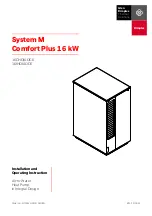
Installation
4
REPLACING AN OLD PUMP
Hazardous voltage. Disconnect power to pump before work-
ing on pump or motor.
Step 1. Drain and remove the old pump. Check the old pipe for scale, lime,
rust, etc., and replace it if necessary.
Step 2. Install the pump in the system. Make sure that all pipe joints in the
suction pipe are air-tight as well as water tight.
If the suction pipe
can suck air, the pump will not be able to pull water from the well.
Step 3. Adjust the pump mounting height so that the plumbing connections
do not put a strain on the pump body. Support the pipe so that the
pump body does not take the weight of piping or fittings.
You have just completed the well plumbing for your new shallow
well jet pump. Please go to Page 6 for discharge pipe and tank
connections.
WELL POINT (DRIVEN POINT) INSTALLATION
(Figure 1)
Step 1. Drive the well, using “drive couplings” and a “drive cap”. “Drive
fittings” are threaded all the way through and allow the pipe ends to
butt against each other so that the driving force of the maul is car-
ried by the pipe and
not
by the threads. The ordinary fittings found
in hardware stores are not threaded all the way through the fitting
and can collapse under impact. “Drive fittings” are also smoother
than standard plumbing fittings, making ground penetration easier.
Step 2. Mount the pump as close to the well as possible
Step 3. Use the fewest possible fittings (especially elbows) when connecting
the pipe from the well point to the pump suction port. The suction
pipe should be at least as large as the suction port on the pump
(include a check valve if your pump is not equipped with one – see
Figure 1). Support the pipe so that there are no dips or sags in the
pipe, so it doesn’t strain the pump body, and so that it slopes slight-
ly upward from the well to the pump (high spots can cause air
pockets which can air lock the pump). Seal the suction pipe joints
with teflon tape or a teflon based pipe joint compound. Joints must
be air- and water-tight.
If the suction pipe can suck air, the pump
cannot pull water from the well.
If one well point does not supply
enough water, consider connecting two or three well points to one
suction pipe.
You have just completed the suction piping for your new shallow
well jet pump. Please go to Page 6 for discharge pipe and tank
connections
CASED WELL INSTALLATION, 2” OR LARGER
CASING (Figure 2)
Step 1. Mount the pump as close to the well as possible.
Step 2. Assemble the foot valve, strainer, and well pipe (see Figure 2). Make
sure that the foot valve works freely.
Step 3. Lower the pipe into the well until the strainer is five feet above the
bottom of the well. It should also be at least 10 feet below the well’s
water level
while the pump is running
in order to prevent the pump
from sucking air. Install a sanitary well seal.
To Household
Water System
Not
to
Scale
Pump Priming
Tee and Plug
Suction Pipe
From Well
Drive
Coupling
Drive
Point
Check
Valve
Priming
Tee and
Plug
Drive point
below water
level
2346 0396
To Household
Water System
Pump Priming
Tee and Plug
Not
to
Scale
Check
Valve
10'
Min.
5–10'
Suction Pipe
From Well
Priming
Tee and
Plug
Foot
Valve
Sanitary
Well Seal
Well
Casing
2347 0396
Figure 1: Driven Point Installation
Figure 2: Cased Well Installation






























